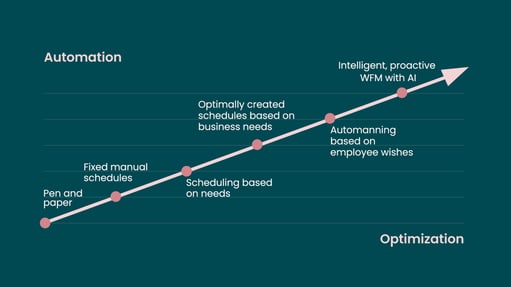What a ride the last ten years have been. The workforce management industry has changed beyond recognition, bringing positive change to the work lives of millions and helping businesses that rely on the deskless workforce become more efficient, productive, and profitable.
If one word can define the last decade it’s disruption.
Workforce management (WFM), in particular, has seen significant disruption to the status quo. Schedules used to be created with pen and paper. Changes to shifts used to be scribbled on a rota pinned to a wall in a staff room. Staff used to write down their schedules on a scrap of paper (which they’d inevitably lose). Managers used to spend hours on the phone trying to find replacements to shifts. It was a frustrating time, a time rife with inefficiency and a time where it was infinitely harder to enjoy work.
Thankfully, WFM - and the way businesses operate - has evolved. Have a look at this graph. Where is your business on the curve?

What has driven the transformation?
Thankfully, we’ve abandoned pen and paper, and instead, find ourselves on a more exciting and less time-consuming path. The combination of technology, changing behaviors of consumers and employees, and the needs and wants of Gen Z and Millennial workers are fuelling both the industry’s growth and its increasing importance to businesses that rely on the deskless workforce.
Cloud computing, market-leading WFM software has also become affordable, scalable, and is constantly improving with regular updates. It brings with it better integration and more robust security. Gone are the days of being reliant on a legacy system or even worse a spreadsheet.
The need to offer and deliver flexibility has been another catalyst behind the way WFM has evolved. With flexibility as a core tenant, the way we work today and the process of doing work is changing right in front of our eyes. The gig economy started this transformation, as a break away from the traditional employment model.
WFM is becoming more intelligent
WFM tools have evolved into the crucial piece of the puzzle that allows businesses to deliver on this promise. It doesn’t end there. An intelligent WFM solution will for example help you to:
- Intelligently automate schedules, based on employee skills and experience, or times of peak demand.
- Warn when scheduled hours exceed budgeted hours or if you have an unhappy employee.
- Gain better control and visibility into the amount of staff overtime, and rationalize how the overtime works.
- Quickly measure, track and predict absence while making it easy to find cover for shifts and to manage leave applications.
- Significantly reduce margins for error by integrating payroll with time reporting and scheduling.
- Reduce the risk of noncompliance with automatic checks against working time directives and employee contracts, ensuring scheduling is always in line with legal requirements.
Put simply, if your business is reliant on a deskless workforce, a WFM tool is the secret ingredient to business optimization. From communication, scheduling, and forecasting through to employee engagement and retention, a WFM software can help you optimize huge swathes of your business and together with automation, AI and machine learning help you create a happy, profitable and successful business with employees who enjoy work.
This is what the future of work - and workforce management - looks like.
Download our free trend guide for more insight into the future of workforce management and to see how we think the industry will evolve further over the coming years.
![<p data-pm-slice="1 1 []">Read more</p>](https://hubspot-no-cache-eu1-prod.s3.amazonaws.com/cta/default/1545537/interactive-303378350296.png)


